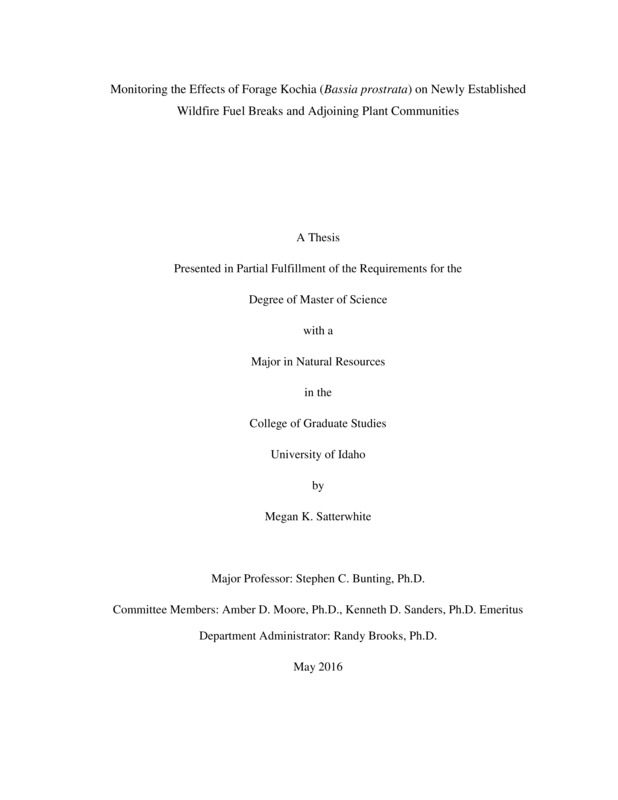Monitoring the Effects of Forage Kochia (Bassia prostrata) on Newly Established Wildfire Fuel Breaks and Adjoining Plant Communities
Satterwhite, Megan K.. (2016). Monitoring the Effects of Forage Kochia (Bassia prostrata) on Newly Established Wildfire Fuel Breaks and Adjoining Plant Communities. Theses and Dissertations Collection, University of Idaho Library Digital Collections. https://www.lib.uidaho.edu/digital/etd/items/satterwhite_idaho_0089n_10840.html
- Title:
- Monitoring the Effects of Forage Kochia (Bassia prostrata) on Newly Established Wildfire Fuel Breaks and Adjoining Plant Communities
- Author:
- Satterwhite, Megan K.
- Date:
- 2016
- Keywords:
- forage kochia fuel break greenstrip invasive annuals wildfire
- Program:
- Natural Resources
- Subject Category:
- Natural resource management
- Abstract:
-
ABSTRACT
Forage kochia (Bassia prostrata) possess unique characteristics that make it an ideal species for greenstrip programs to break-up fuel continuity. Land management agencies are sometimes hesitant to use this species as part of a fire suppression and fuels reduction program because of its reported invasive potential and unknown interactions among the native plant communities.Greenstrip seeded areas,established by the Bureau of Land Management, were sampled to better understand forage kochia establishment, invasive potential and interactions with other plant species. The study sites were located approximately 32 kilometers north of Minidoka, Idaho and adjacent to Craters of the Moon National Monument and Preserve. In 2012 soil attributes were analyzed, specifically soil electrical conductivity (EC) and soil sodium absorption ratio (SAR) , to determine the effect of saline and sodic soil conditions on forage kochia establishment. In 2012, 2013, and 2014 rooted frequency and percent cover was measured for all plant species present in both treated and untreated transects at each study site. There was a significant positive relationship between soil salinity (EC) and forage kochia frequency and percent cover. There was a significant positive relationship between forage kochia cover and SAR. With EC values ranging from 0.35-4.2, soil salinity had a significant positive relationship on perennial grasses and had a significant negative correlation with annual forbs. Sodium absorption ratio had a significant negative correlation on perennial forb cover. Forage kochia abundance increase significantly within the treated areas study wide for both cover and frequency sampling methods. Frequency and percent cover sampling methods did not detect forage kochia beyond the treated study area 4 and 5 years after planting. Over the three year sampling period there were no significant changes in cover for either the perennial or annual plant communities species. However, there was a significant increase in shrub cover, suggesting that the landscape is moving toward a more stable, shrub-dominated state. Over the three year sampling period, there was a significant negative correlation between bareground and forage kochia cover and a significant positive correlation between litter and kochia cover. Species richness was significantly higher for the the treated transects compared to the untreated transects. However, there were no significant differences in the Shannon-Wiener Index for diversity between the treated and untreated transects. These findings suggest that forage kochia is tolerant of saline soils, has low invasive potential, contributes to landscape diversity, and that the presence forage kochia does not alter the perennial and annual plant community.
- Description:
- masters, M.S., Natural Resources -- University of Idaho - College of Graduate Studies, 2016
- Major Professor:
- Bunting, Stephen C.
- Committee:
- Moore, Amber D.; Sanders, Kenneth D.
- Defense Date:
- 2016
- Identifier:
- Satterwhite_idaho_0089N_10840
- Type:
- Text
- Format Original:
- Format:
- application/pdf
- Rights:
- In Copyright - Educational Use Permitted. For more information, please contact University of Idaho Library Special Collections and Archives Department at libspec@uidaho.edu.
- Standardized Rights:
- http://rightsstatements.org/vocab/InC-EDU/1.0/

